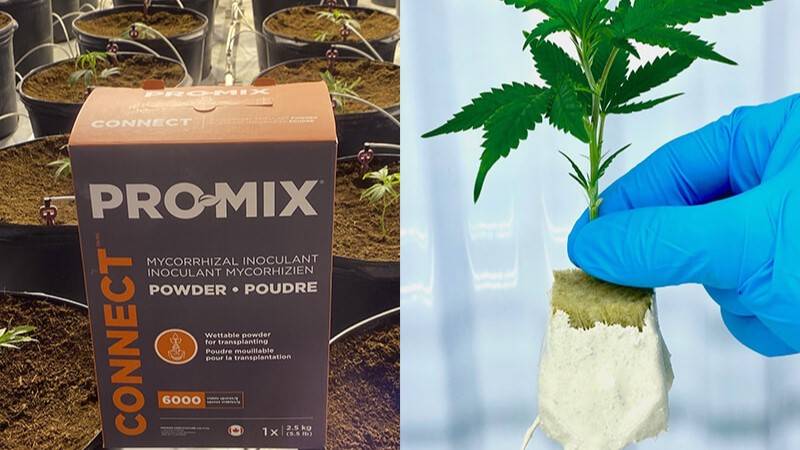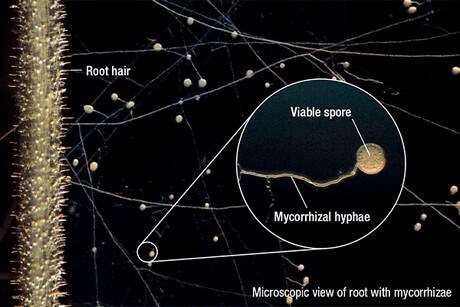Mycorrhizae: Fulfill the Genetic Potential of Your Medicinal Plants

Achieving such a feat as reaching the optimal result with a specific plant strain doesn’t happen just by chance. Science and technology are essential to bringing the best out of the hidden power of your plant. Active ingredients, such as mycorrhizal fungi, are part of the equation. Let me explain why.
Usually, when talking about the impacts of mycorrhizae, you only hear about the nutrient and water uptake capacity. The results on your crop mostly revolve around better and faster growth. Even if that remains all true, it goes well beyond. By inducing a global systemic reaction inside the plant, mycorrhizae will help reach its full genetic potential. I am talking about stimulating the natural chemotype of a plant. For medicinal plants, you probably guessed, it means increasing the synthesis of molecules such as terpenes and cannabinoids.
Not All Mycorrhizal Inoculants Are Equal
Before going any further, it’s important to understand that not all mycorrhizal inoculants are created equal, and it’s especially true for medicinal plants. When dealing with a microorganism and a fairly short crop like medicinal plants, you don’t have much space for mistakes or a second chance. It needs to work, and it needs to work quickly to see the full benefits. It means that to be truly efficient, a mycorrhizal inoculant needs to be at least three things:
| Viable | Close | Concentrated |
|---|---|---|
| It needs to be viable when it's finally time to use it and remember only a viable spore (fungi seed) can colonize a root efficiently. | It needs to be applied close to the root system to allow the symbiosis to happen as quickly as possible. | It needs to be concentrated to get a stronger reaction and a better chance to connect efficiently. |
PRO-MIX Mycorrhizal Inoculant CONNECT has been designed for growers by keeping these three aspects in mind. With 6000 viable spores per gram, this inoculant is the most concentrated product of its kind on the market. By applying it as a slurry on your rooted cuttings when transplanting, you obtain approximately 30 000 viable spores in direct contact with the root system. The symbiosis will happen, and it will happen fast.

Systemic Reaction - The 4 CS
That being said, let’s go back to our global systemic reaction. Before getting the nutrient and water uptake benefit out of the mycorrhizae, there is a full process that both organisms, the plant and the fungi, must go through. The entire process can be slimmed down to 4 steps, or the “4Cs” as I like to refer: The Call, The Contact, The Connection and The Completion. In other words, it’s the establishment of a relationship. It’s important to understand that physical and chemical processes are linked together when dealing with plant physiology. Because of that, even small changes can lead to an overall greater reaction.

Pre-symbiotic Phase
When the plant is inoculated, the spores must germinate towards the roots to survive. That’s why the roots and the spores produce chemical signals in the soil to communicate. They basically CALL (Step 1) each other, the results being the spores germinating in the right direction, and the roots preparing themselves for their arrival. At some point, the hyphae will make Contact (Step 2) with the root surface and make their way inside the root cells. Those first two steps, The Call and The Contact, are the pre-symbiotic phase. Even though symbiosis is not yet established, this phase impacts the plant metabolism. In short, by chemically communicating and physically interacting with the fungi, the plant is stimulated and starts to produce more metabolites (Isoprene), essential to the production of terpenes and cannabinoids. The more Calls and the more Contacts you get, the greater the stimulation.
Symbiotic Phase
Then comes the symbiotic phase. When a hypha reaches the cortex (cell layer under the epidermis of the root), it penetrates the root cell and produces an arbuscule. These arbuscules are the distribution centers between the fungi and the plant; that’s where they exchange nutrients, water, sugars and lipids. When arbuscules are produced, The Connection between the fungi and the plant is established. That Connection generates physiological and chemical changes inside the colonized cells. Those changes lead again to the production of more metabolites (Isoprene).
At this point, the mycorrhizae can develop themselves and produce a secondary root network of filaments that will explore the soil and search for more nutrients and water. The Completion of this process leads to the renowned effects of mycorrhizae in the industry: faster growth (shorter veg time), stress resistance, increased yield and better trichrome density. All of that is on top of the increased potency (THC, CBD, etc.), and the improved terpenes profile.

The bottom line is that mycorrhizae are great for increasing your yield, but also the overall quality of your crop, provided your mycorrhizal inoculant has what it needs. The profitability upside makes it a no-brainer for every grower looking to push forward the limit of his of her plants.
Mathias Plourde, Chemist, M. Eng.